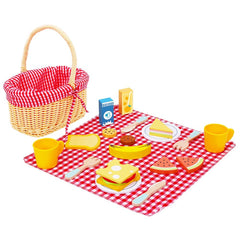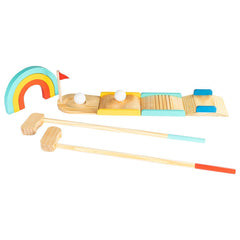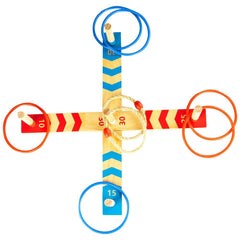The children’s doctor set has so much to offer. You can literally define it as the gateway to a world of care, learning, and imagination. Taking these factors into consideration, Barnshenn introduces a sturdy doctor's set for kids.
Made from sturdy wooden toys, the set includes 11 child-sized pieces, such as a stethoscope, thermometer, wooden pills, and an eye check board. Each tool supports imaginative play and gently teaches empathy, communication, and basic health awareness to kids.
But can we now make the healthcare playset more productive? Let us explore five creative games that you can use to maximise the benefits of the doctor's role-play toy.
1. Teddy Bear Check-Up
Children befriending their soft toys is the most natural thing to witness. If you have seen your toddler being friends with their plushie, too, try this game. In this game, your child can pretend that their favourite teddy bear is feeling poorly. Once diagnosed, they can use the thermometer to check its temperature. If the matter seems worse, they can also use a stethoscope to check its heartbeat.
This chain of activities helps kids understand the use of basic health tools. Furthermore, these activities assist children in learning how to care for others.
2. Family Clinic
This dynamic game makes complete use of your home by turning it into a clinic. In this clinic, your child gets to be a doctor while you act like patients. You can try making this game more realistic by coming up with made-up problems such as a sore throat or a tummy ache. It will urge your child to use the doctor set for kids for so many tasks. These tasks include checking symptoms, prescribing medications, and maintaining medical records.
In the larger picture, it builds confidence and teaches how to communicate kindly with others.
3. Eye Test Challenge
This game enhances the experience by directing the focus towards vision and observation. This feature means that now, the players are not just acting as general doctors; they are focusing on the specifics of being an eye doctor. This ability is made possible by the wooden eye check board included in this set, which allows your child to take on the role of an eye doctor.
It pushes them to concentrate and observe. Additionally, it introduces the idea of regular eye care in a soft and playful way.
4. Ambulance Role Play
This gameplay provides everything your child needs, as it allows them to take on tasks such as answering phone calls. It starts with your child imagining getting an urgent ambulance call. Following this call, they carry their doctor’s bag and rush to their patient who called for help. There, they use various tools like the thermometer, syringe, or stethoscope to “treat” the patient.
Needless to say, this game enables children to be on their toes and respond quickly in case of emergencies. And they can only do so if they think quickly and stay calm under pressure.
5. Doctor’s Office Appointment Game
This gameplay involves just one section of a room where your little doctor switches roles. Here, your toddler assumes the receptionist's desk and maintains the medical record card. Looking at the records, he calls in the patients one by one. He also calls in patients one by one. Meanwhile, he also tells the person who is next in line to be ready.
This form of role-play allows children to gain a deeper understanding of the significance of diverse clinic roles. It helps them realise that there are various roles to assume beyond just being doctors.
The Role of Imaginative Play in Child Development
Imaginative play is one of the best ways to teach children how their surroundings work. For instance, when your toddler picks up a stethoscope and plays a doctor, they understand hospitals better. They also tend to think more rationally and learn while they play or role-play.
Role-play provides toddlers with an opportunity to reflect on the perspectives of others. This activity fosters empathy and instills a sense of responsibility. These are essential life skills that will help them in every stage of life.
Thus, pretend play toys, like a doctor set for kids, are powerful building blocks for development. They assist in blending playtime with learning and let children understand their surroundings.
What Makes the Barnshenn Doctor Set Stand Out?
We specifically design our children's doctor set for early learning, making it ideal for small hands and active imaginations. Let us look at some more reasons that set us apart:
The set includes 11 pieces made of soft fabric. This accessory accessory accessory enables your child to carry stuff around and shift his clinic from one room to another. Additionally, it instructs them on how to store and tidy up after their playtime.
The set has so many safely crafted wooden tools. This means that the tools are safe, smooth, and sturdy, making them perfect for toddlers.
The set doesn't have random stuff. It rather has all the necessary items, such as a wooden stethoscope, thermometer, syringe, medicine bottles, and pretend pills.
Other pieces, like the eye check board and medical record card, add stars to the learning opportunities. As a result, these items enhance the sense of realism.
Conclusion
Barnshenn's doctor set creates a safe space for children to learn and flourish. It encourages them to look deeper inside their emotions and practise sympathy. So, whether they pretend to be a doctor, a receptionist, or an ambulance responder, they learn something regardless.
On top of it, our doctor set for kids is made up of child-friendly wooden pieces. So it is safe for toddlers. It is also the kind of toy that fosters imagination and helps students comprehend real-life situations.
In summary, Barnshenn values strong foundations and guides your toddler in the same direction. This game raises your toddler to be confident, caring, and curious.
FAQs –
Q1. Is this doctor play set suitable for toddlers?
Yes, it’s safe for children aged 3 and up, made with smooth, child-friendly wooden parts.
Q2. How many pieces does the Barnshenn doctor set include?
The set comes with 11 pieces, including tools like a stethoscope, thermometer, medical bottles, and more.
Q3. Can this toy help with doctor-related anxiety?
Yes, children become more comfortable with medical tools and routines, which can reduce fear of real-life doctor visits.
Q4. Why should I pick wooden toys over plastic ones?
Wooden toys are long-lasting, non-toxic, eco-friendly, and offer a more calming and sensory play experience.





